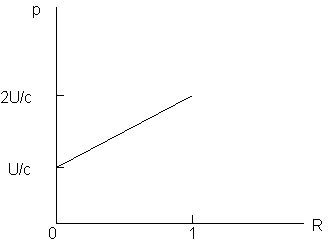| Ch. 34 |
5 |
7 |
16 |
17 |
25 |
29 |
31 |
63 |
| More
Helpers |
|
Answers |
| 5.
The vector B vibrates along the z-axis, while the vector E vibrates along
the y-axis. See fig 34.3. (a):

(b):
Bm = Em / c
For the direction, think about the Poynting vector in section 34.3:

Using the right hand rule for cross products, we see that your thumb points
along the direction of the Poynting vector S, which is the same direction as
the propagation of the wave. This is the positive x direction, as can be
seen by the negative sign in the argument of the cosine. You index finger
points in the negative y direction. Thus, in what direction does your middle
finger point ? This will give you the direction of the B vector at that
moment.
(c) Solve for:

|
| 7. (a) Bm = Em / c
(b):

(c):

In addition, you should ask yourself: Along what axis does the vector B vibrate ?
|
16.

Solve for Bm. |
17.
(a) The intensity I is the average of
the absolute value of the Poynting vector:

Here,
Here the brackets mean the average value.
Now,

Note that Power = i2R.
Here i is the current and R is the resistance. Find the intensity and hence the average of
the absolute value of the Poynting vector. Finally, let's deduce the direction of the
vector S. The vector E points along the current i and the vector B is tangent to the wire
and perpendicular to the current. The direction of the vector B can be found from the
right hand rule in sec. 30.3.
Since,
 , ,
we see that the vector S points inward toward the center of the wire.
(b):


|
25. See eqn. 34.24, assuming complete absorption.
|
| 29. 
Here area = area of a circle of radius r.
(a) You know what to do!
(b):

 . .
(c) momentum = energy / c .
|
31.
(a) energy = (0.5)( I )(area)( time). Remember to convert the time to seconds.
(b) The momentum increment varies
in the following range:
 . .
The lower limit is for complete absorption and the upper limit is for complete reflection.
In this case we have a fraction 0.5 for the amount of radiation absorbed and
0.5 for that reflected. Visualize in your mind the following graph of p versus the amount
R reflected:

This graph corresponds to the limits discussed above. When R = 0, complete absorption, we
have p = U/c and when R = 1 , complete reflection, p = 2U/c. Interpolate between the two
limits to get p when R = 0.5.
|
| 63. 
This is the expression for the magnitude of the force on the bead, assuming complete
absorption. (For partial absorption, you would apply the analysis in problem
31 to obtain
the correct numerical factor between the values 1 and 2. In this problem, you use the
factor of value 1. On an exam, you might be asked to calculate the force in the more
general case. Be vigilant !)
In the above formula, use the area of a circle of radius r, the radius
of the bead.
Now, the upward radiation force must be balanced by the downward force of gravity of
magnitude mg:

Find r from the mass m and density given, using the formula for the volume of a
sphere of radius r.
(a) Solve for I
(b) Power = (I)(Area). Here Area = crossectional area of the laser beam of radius R
= 0.002 m.
|
